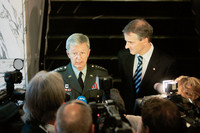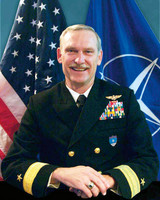9,000 NATO Commandos In Adriatic OperationLARGEST MILITARY MANOEUVRE IN CROATIA
NACIONAL REVEALS the details of a mass military exercise involving the NATO Response Force, to be held in cooperation with the Croatian Army from 1 to 12 October of this year in central and northern Dalmatia and Istria
NACIONAL REVEALS the details of a mass military exercise involving the NATO Response Force, to be held in cooperation with the Croatian Army from 1 to 12 October of this year in central and northern Dalmatia and Istria From 1 to 12 October 2007 Croatia will be the scene of Noble Midas 07, the largest and most important international military manoeuvre to be held in Croatia since its independence. Some 9,000 soldiers from NATO's Response Force and marine commandos, 50 warships, an aircraft carrier, amphibious vehicles, frigates, cruisers, submarines and some 60 NATO member aircraft will stage the largest NATO military exercise of the year in the northern and central Adriatic Sea.
Effectively, this manoeuvre is the last obstacle, but also the ticket to Croatia's NATO accession, given that the spring 2008 Bucharest session of NATO is expected to invite Croatia to accede to full membership. A successfully implemented exercise, its organisation, the reception of this number of NATO troops from over ten member states, the ability of the Croatian Armed Forces and the capability of its military hardware to operate with NATO special forces during the manoeuvres will to a large extent define the position towards Croatia in anticipation of an invitation to full membership.
A two-thirds majority of MPs in Croatian Parliament approved the Noble Midas 07 exercise on 8 December 2006, but the complexity and scale of the military exercise was not then known. At the political level the most important role in bringing the exercise to Croatia was played by Croatian ambassador to NATO Davor Bozinovic, while military preparations for the exercise scenario were entrusted to Captain Robert Hranj, serving as the head of the Office for NATO at the Croatian Ministry of Defence. Indicative of just how important this exercise is the fact that it will, for the first time in NATO history, be held in a non-member country, a precedent for the alliance, and which on the other hand speaks volumes of how strategically vital Croatia's maritime position is and of its future role in preserving security on the Mediterranean. To show a form of gratitude for the efforts Croatia is making in approaching NATO, and in the war on terror in Afghanistan, NATO officials have decided that the alliance's highly specialised forces, which, after four years of organisation and training, only became fully operational last year at the Riga summit, hold the largest military manoeuvre since then right here in Croatia.
 |
General Bantz Craddock
|
GENERAL BANTZ CRADDOCK is the allied forces supreme commander in EuropeThere are several key elements that will influence the final analysis of Croatia's participation in the exercise, i.e. Croatia's readiness to take on full NATO membership. This involves, first of all, NATO's concept of host-country support whose aim is to do everything related to logistics in the reception of allied forces on its territory, on land, sea and in the air. Pula, Zadar and Split are most likely to be responsible for organising the reception of NATO's forces in the manoeuvre. All 9,000 NATO special forces will not, of course, be accommodated on land, but conditions for all living and working conditions will have to be secured on the Croatian coast for a part of them. It should be noted that the Croatian defence ministry and the Croatian Armed forces are not the only institutions responsible for an overall positive response to the exercise - the task will be equally the responsibility of the interior ministry, the transport ministry, Government's PR Office, the foreign affairs ministry, coastal cities and some ten other national institutions.
Taking a direct part in the manoeuvres alongside NATO commandos will be Croatian land, sea and air forces with a dozen vessels, a landing ship, a minesweeper, a missile gunboat, patrol ships, anti-mine divers, likely members of the commando infantry forces of the 4th Guard's Brigade, and the possible participation of two Croatian MI-8 helicopters reserved precisely for NATO exercises cannot be ruled out. In the exercise scenario the Croatian Armed Forces will play the role of forces opposed to NATO's, customary for host countries of these types of manoeuvres.
The manoeuvres will be a direct test of just how ready the Croatian Armed Forces are to assume the role of controlling and protecting the entire Adriatic Sea, of which there has been serious discussion for several months now, and then how much more it needs to work on including its own military forces into NATO's concept of rapid response forces and whether they are capable of operating at sea in coordination with elite NATO forces. Croatia has obliged itself in its long term development plan that its own rapid response force will be ready to intervene within 24 hours in various types of emergency situations in the country, and within five days if Croatian forces are deployed in the frame of a NATO forces rotation outside Croatia.
 |
U.S. Admiral Michael Groothousen
|
MICHAEL GROOTHOUSEN, US Admiral, heads the NATO naval forcesOne motorized company, a special operations company with a part of the naval infantry troops, an engineer platoon, a nuclear-chemical-biological protection platoon, a signals platoon, a platoon of military police, a transport platoon and medical team, Air Force units including the two duty fighter jets, two transport helicopters, two PC-9 aircraft and two Coast Guard vessels will always be in this level of readiness.
A detailed scenario of the exercise in the Adriatic Sea is currently being worked out, with a Final Planning Conference scheduled in Split from 5 to 7 July. The work foresees the participation of experts from all relevant areas, including environmental protection specialists, in order to ensure that the maneuvers are held in line with Croatian legislation and international standards.
Interested institutions of civil society will be contacted in the interest of opening dialogue. And although the complete scenario of the October military exercise is not yet known, Nacional has learned that the NATO naval units of the rapid response force will practice detecting and seeking out enemy submarines, a beachhead commando landing supported by some 60 aircraft, the transport of special forces by helicopter from ship to shore and the like, during the two-week Adriatic maneuvers.
NATO's rapid response forces have been developed as the result of a new strategic concept in which the speed of operations is one of the crucial factors in mission success. At one point NATO found itself at a crossroads. It is nowadays difficult to imagine a cold-war type frontal military conflict with a clearly defined battleground. The new challenge of terrorism has taken NATO out of its own yard. Modern threats further hamper armed forces operations, which need to be quickly deployed, ready and independent in the field. All of these kinds of threats usually occur, anyway, in areas very distant from national territories. Soon after Prague NATO began preparing itself for a conflict with global terrorism.
One of the key changes in NATO was the organization of NATO rapid response forces. These are units operating at an exceptionally high technological level, high capabilities, ready to deploy anywhere on the shortest notice. One cannot, of course, speak of a standing NATO army in the real sense of the word. In order for rapid response forces to have an immediate operational capability, it was necessary at the political, within a troop rotation, to come to an agreement on the so-called transfer of competencies, i.e. to create a military force of this kind without the national limits that have always been a great hindrance to NATO's quick response at any location. The old NATO was founded on a national responsibility to approve the deployment of national forces. In practice this means today that the rapid response troops are under the authority of the supreme commander of Allied Forces in Europe, currently US General Bantz John Craddock. The rapid response force is composed of multinational land, naval and air special forces components. They number over 20 thousand members that can be ready for deployment within five days of a command and operate independently in the field for a month of more. Rapid response forces are conceived for deployment in any part of the world if the North Atlantic Council, NATO's top political body, made up of the foreign affairs ministers of all member countries, so decides. The force can operate in a wide range of missions ranging from non-combat evacuations, humanitarian missions, crisis response operations, peacekeeping, counter terrorism, embargo monitoring operations to combat operations.
The rapid response forces are composed of land components of various brigades, naval special purpose forces consisting of an aircraft carrier battle group, an amphibian group and an air force component capable of executing up to two hundred actions a day. Along with all that the forces also have special units at their disposal. These are the units first in and first out of a crisis area in preparation the ground for the arrival of larger allied forces. The rapid response forces were officially presented on 15 September 2003 in Brunssum, along with Naples and Lisbon, one of the three command centers of the Allied Forces in Europe. They then had 9,500 members, and numbered 17 thousand a year later when they reached initial operative capability. They achieved full operational capability last year in November and number 25 thousand soldiers.
Maneuvers to be led by US generalsThe military maneuvers to be held on the Adriatic Sea from 1 to 12 October are to be led by General Bantz Cradock, commander of all NATO operations in Europe. Joining him in command will be Admiral Henry Ulrich, who heads the response force stationed at Naples, and Admiral Michael Groothousen, the chief of NATO naval forces. There is not requirement for the approval of bodies of the national administration for the operations of the units that will be involved in the maneuvers in Croatia.
Largest Military Maneuver in CroatiaFrom 1 to 12 October 2007 Croatia will be the scene of Noble Midas 07, the largest and most important international military maneuver to be held in Croatia since its independence. Some 9,000 soldiers from NATO's Response Force and marine commandos, 50 warships, an aircraft carrier, amphibious vehicles, frigates, cruisers, submarines and some 60 NATO aircraft will stage the largest NATO military exercise of the year in the northern and central Adriatic Sea.
Source:
http://www.nacional.hr Formatted for CROWN by Marko Puljiæ
Distributed by www.Croatia.org This message is intended for Croatian Associations / Institutions and their Friends in Croatia and in the World. The opinions / articles expressed on this list do not reflect personal opinions of the moderator. If the reader of this message is not the intended recipient, please delete or destroy all copies of this communication and please, let us know! Or simply...enjoy and spread the word and good vibrations.